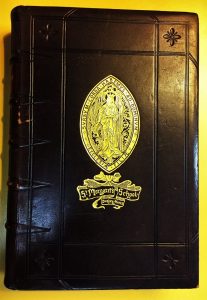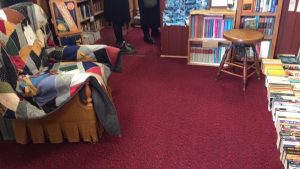It’s pretty hard to miss this shop while taking a stroll through Selinsgrove. The large wooden sign painted “DJ ERNST BOOKS” hangs straight above the doorway pointing your eyes to the giant windows on either side, these windows hold an array of books to welcome you in. Looking into the right-side window there is a lamp that lights Ernst’s front counter and a figure lost in a book or surfing his Facebook for book enthusiasts.

“I can’t really explain it”, Ernst said from across the room, watching as I walked through his store trying to figure out the way he had designed the interior of the building. I laughed when he said that because I can see what he means, Ernst sandwiched Hunting and Gun books in between American Literature and Poetry, while on the other side he has Mythology next to Nature and Outdoors, random right? But this “unsystematic” assorting of his collections and the way his store is designed creates a unique identity that displays more then just a personal bookstore. Getting a sense of the personality that makes up DJ Ernst’s bookstore is really just an open door to finding out who Ernst as the bookseller really is.

At first glance walking into the shop you see a giant awkwardly shaped display of books smack in the middle of the store. This shelf from what I observed is made up of small and tall shelves, a table, and a couple of random wooden pieces placed nicely together. This giant mix-matched shelving is shifted a little to the left when you walk in creating a channel that faces Ernst as he sits at his front counter. This system holds a variation of books that are displayed either facing you when you first walk in, spine out, or even the cover facing up. It is not the type of shelving you would see at a corporate bookstore since they would display their books in rows and columns of straightforward shelving, but there is true character behind this funky shape that makes his system so attractive. It is cleverly placed in the center forming a pathway around the perimeter of his store, which directs the overall traffic throughout the building. This is a creative way to keep the viewer intrigued and their eyes constantly active, having this busyness makes it easier for a consumer to get “lost” within the store. The times that I visited the bookstore I found that other customers did follow this path that Ernst may or may not have intentionally created. Regardless of if the customer was to start their journey on the right or left side of the store they always walked around the entire perimeter either once, or multiple times.
When observing the opposing sides of the center shelf, books are placed on tall wooden shelves with their genres handwritten on old pieces of paper. Most books are placed on the shelves, but there are also three rows of books stacked on the floor, spine up, in front of the shelves filling the perimeter of the store. Whether you look up to the ceiling, or down to your feet the place is completely covered in books. Ernst talks about not really knowing how to be a bookseller when he started out, and this experience stemming from a passion that he shared with his father. You can tell by the set up of the store that Ernst doesn’t look into the nit picky details of how to organize the business; it is merely groomed out of that hobby that he formed the store from. He doesn’t categorize the genres to the closest topics that they are related to, but he does organize the books based on a certain order in a collection, or multiple copies that are placed together.

It is apparent what is important to Ernst as an individual and bookseller when looking through the store. Ernst surrounds every inch of wall space with various possessions like postcards, pictures of his family, articles cut out from newspapers about his store, and multiple maps and images of Pennsylvania. Ernst mentioned how he is a “specialist in early on Pennsylvania history and local history”, which I would have never picked up on until I talked to him, and then observed his store. This specialty was only introduced in the 80’s, a little after he first opened and when his customers were interested in this topic. The pictures and collections hanging up felt like a timeline of Ernst and his connection to his bookstore and how he grew as a bookseller. You can tell that he is proud of the accomplishments and how he has grown from not knowing anything about the practice, to owning his own business through the various newspaper articles hanging around his store. A various wall of memories are shared whether it is a shout out from the town’s newspaper or him and his father inside it, every moment has been captured and hung up.
The true identity of Ernst’s store is not apparent at first, but I figured it out as I started to write, it really splits into a two thematic identities. I think that the stores true character is personalization, for the hominess aspect he tries to go for, along with Ernst’s constant reactionary attitude towards his customers. The second would be his own self-identity, you can really read the store and watch this large “timeline” of Ernst finding out who he was and is, learning what has molded his experience into the bookseller that he is today.

Ernst has created an identity of a “safe, homey place” for the community and those interested in visiting him. You get a warm feeling walking into the store having an old fashioned lamp and dim lights along with a comfy couch. The Sisterhood bookstore explained how their identity was “to be more than just a place to buy books” (96), and that’s exactly what Ernst has generated within his store. It is interesting how Ernst has placed the chair facing the front counter that he sits behind. He mentions that individuals from the Selinsgrove community always come in and sit on the worn out rocking chair with a colorful knitted blanket to talk for hours. It could range from talking about Philosophy to WWII and even for some, a trip after the bar for a “how are you” conversation. And most times these community members leave his store empty handed, but the openness that Ernst gives for a conversation and a place to sit back and relax makes the community feel welcome. He never passes on the opportunity to learn new things as he helps his customer’s branch out on topics that they are interested in. The Gun’s and Hunting section only started to grow after an individual started to come in and was interested in strictly hunting. Ernst took into consideration that Fishing and Gun books might be of interest to this specific gentleman that always comes in. These books are all placed in the front of the store and all together. The reactionary side of Ernst being a bookseller gives him the opportunity to give his consumers a variety of topics they may be interested in. Who knows, Poetry might be of interest to this hunter as he looks through the various collections Ernst has formed for him.
Picking apart Ernst’s bookstore gives me the ability to understand who Ernst is as a person, bookseller, and the way he interacts with his community. This hidden gem is more then just a personal bookstore; it’s Ernst’s life.
Sources
Text
Spain, Daphne. Constructive Feminism: The Feminist Bookstore: Building Identitiy. Ithaca, NY: Cornell University Press, 2006.
Images
By: Valorie Erickson
Courtesy of: Ernst’s Facebook Page; Study of Gospel’s Image

0 Comments